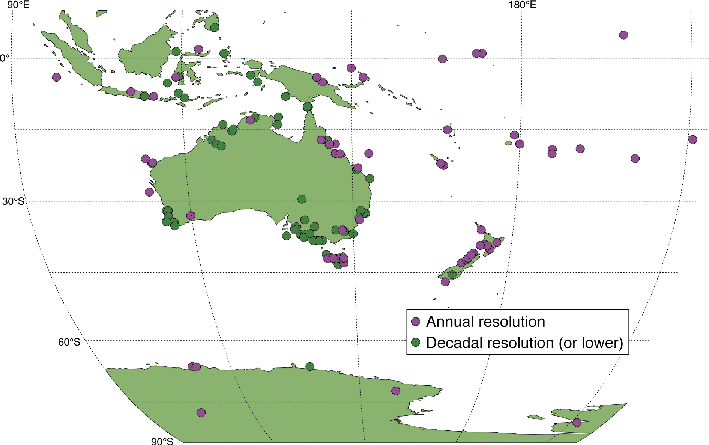- Home
- Publications
- PAGES Magazine
- Australasia’s Climate Variability: Clues Drawn From Paleoclimate and Model Data Over The Last 2000 Years
Australasia’s climate variability: clues drawn from paleoclimate and model data over the last 2000 years
Joëlle Gergis, P. Hope, N. Abram and B. Henley
Past Global Changes Magazine
22(2)
101
2014
Joëlle Gergis1, P. Hope2, N. Abram3 and B. Henley1
3rd Aus2k workshop - 26-27 June 2014, Melbourne, Australia
The aim of the 3rd Aus2k workshop was to review progress made by the Aus2k community to date, and to specifically plan how Australasian science will contribute towards Phase 2 of the PAGES 2k Network. Around 40 paleoclimatologists, meteorologists, hydrologists, and oceanographers attended the workshop, resulting in a very constructive and stimulating cross-disciplinary meeting.
The Aus2k working group took the opportunity to hold the workshop jointly with the Australian Climate Change Science Program (ACCSP), and present the results of their joint paleoclimate data-climate model comparison project Variability of Australian climate over the last 1000 years in coupled model simulations and proxy data. The intention was to engage the wider meteorological community with expertise in climate data-model comparison and diagnostic analyses, and work towards the ultimate goal of understanding the mechanisms driving Australasian climate variability over the last 2000 years.
The specific goals of this workshop were to:
• Expand the Aus2k database to incorporate low-resolution material for the development of a common dataset for Australasian climate reconstructions;
The database will be frozen on 31 December 2014. Contacts for data submissions or questions: Bronwyn Dixon, Jonathan Tyler and Ben Henley
• Develop guidelines for the future collection of climate proxy records based on spatial and temporal gaps in the Australasian paleoclimate record;
Nerilie Abram will lead the testing of the number and location of records required to reconstruct specific features of Australian climate and to deal with potential biases caused by non-stationarities.
• Discuss existing multivariate data synthesis techniques being used by the Aus2k and global 2k communities. Discuss setting a post-meeting goal to run a comparison exercise using different reconstruction methods;
An inter-comparison project with Australian and New Zealand data will be coordinated by Ben Henley, Mandy Freund and Andrew Lorrey.
• Assess the feasibility of developing Australasian climate field reconstructions (temperature, precipitation, and geopotential height) to contribute towards the global PAGES 2k Network;
To be led by Joëlle Gergis, Andrew Lorrey and Steven Phipps.
• Foster linkages between the paleoclimate and climate modeling communities, with the aim of closing the loop between proxy development, data synthesis and climate modeling. Modeling contacts: Steven Phipps and Duncan Ackerley; Modern climate: Pandora Hope.
Day one of the workshop showcased recent research developments in regional data synthesis; opportunities for collecting new paleoclimate records from the region in the future; reconstructions of climate drivers such as El Niño–Southern Oscillation (ENSO) and the Southern Annular Mode (SAM); and climate modeling being undertaken in Australia and internationally.
A range of projects including paleoclimate runs with CAWCR’s ACCESS model; testing the assumption of teleconnection stationarity; and pseudo-proxy exercises to test the fidelity of paleoclimate reconstructions were discussed and collaborative contacts made.
Day two focused on i) developing the database of Australasian low-resolution records, including data consolidation and directions for future data collection; ii) multi-archive data synthesis techniques being used by Aus2k and the PAGES 2k Network, and iii) climate field reconstructions and climate modeling.
 |
|
Figure 1: Locations of annually resolved and lower resolution paleoclimate archives in the Australasian region. |
It was agreed that the Australasian region’s “low resolution” database for Phase 2 would be frozen on 31 December 2014 to allow for consistency in subsequent climate analyses undertaken by the group. It was agreed that reconstructions based on records with higher time uncertainty should form an independent way to verify low frequency trends and variability identified from the more chronologically precise high-resolution material. Figure 1 shows the current spatial distribution of these two datasets.
The final discussion focused on developing a temperature field reconstruction for Australia within the Phase 2 timeframe of the PAGES 2k project. Climate modeling and data assimilation might assist with this. The workshop wrapped up by developing sub-groups based around the five workshop objectives (as listed above) and a clear forward direction that will help deliver Australasia’s best available science in Phase 2 of PAGES’ 2k Network project.
The next Aus2k workshop will be held in Auckland, New Zealand in the austral spring of 2015.
A longer version of this workshop report is available online at http://pastglobalchanges.org/calendar/2014/127-pages/1198-accsp-aus2k-wshop
affiliations
1School of Earth Sciences, University of Melbourne, Australia
2Australian Bureau of Meteorology, Melbourne, Australia
3Research School of Earth Sciences, Australian National University, Canberra, Australia
contact
Joëlle Gergis: jgergis unimelb.edu.au
unimelb.edu.au

